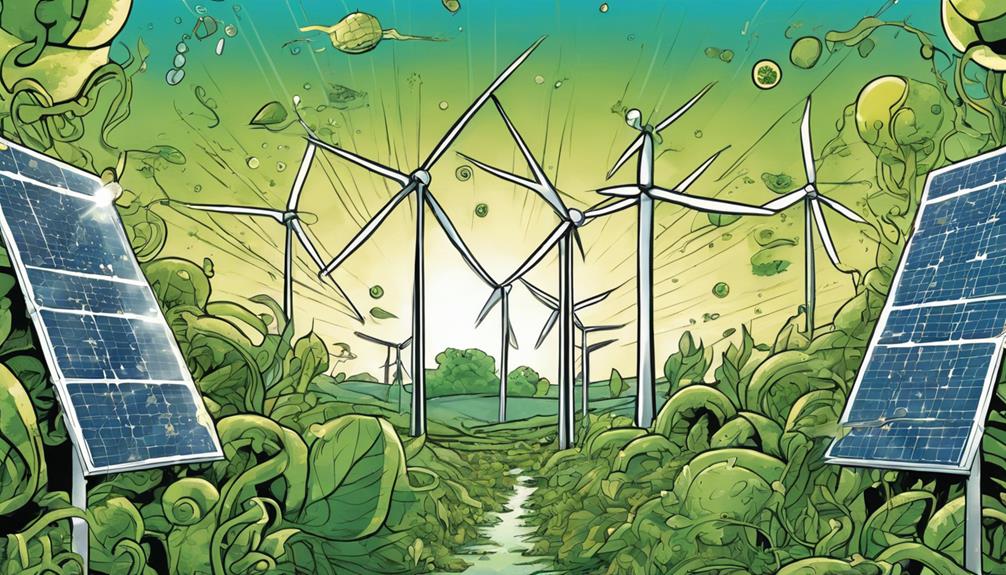As I explore the fascinating world of solar energy trapping, I'm struck by the remarkable diversity of organisms that have evolved to harness the sun's power. From plants and algae to bacteria and fungi, each has unique mechanisms and strategies to capture sunlight. Plants use chlorophyll, algae employ pigments for biofuel production, bacteria convert sunlight into oxygen and glucose, and fungi utilize melanin to generate energy. These organisms play an essential role in converting sunlight into usable forms of energy, and understanding their mechanisms can inspire innovative solutions for renewable energy. As I dig deeper, I'm excited to uncover more about these incredible solar energy trappers.
Key Takeaways
- Plants, algae, bacteria, and fungi employ unique mechanisms to trap solar energy, utilizing pigments like chlorophyll and melanin for photosynthesis and energy production.
- Algae's high solar energy conversion efficiency makes them a promising source for biofuel production, with researchers optimizing cultivation techniques for maximum energy utilization.
- Photosynthetic bacteria, like cyanobacteria, convert sunlight into oxygen and glucose, contributing to the Earth's energy balance and ecological health.
- Fungi's adaptive strategies, including melanin-based energy trapping and mycelium network expansion, enable them to thrive in diverse environments and offer insights for renewable energy applications.
- Understanding the diverse mechanisms of solar energy trapping in organisms is crucial for developing innovative, sustainable solutions for renewable energy production.
Key Takeaways

As we explore the fascinating world of solar energy trapping, it becomes clear that diverse organisms, including plants, algae, bacteria, and fungi, have evolved remarkable strategies to harness the sun's power, converting it into various forms of energy that sustain life on Earth.
These organisms have developed unique ways to capture sunlight, from chlorophyll in plants and algae to melanin in fungi. I'm struck by the efficiency of algae, which can convert sunlight into chemical energy at a significant rate, making them a promising source for renewable energy.
Meanwhile, photosynthetic bacteria like cyanobacteria play an essential role in the carbon cycle, and fungi's unexpected ability to trap solar energy opens up new possibilities for energy utilization.
Plant Solar Energy Conversion

Converting sunlight into chemical energy, plants have evolved a sophisticated machinery to harness the sun's power, with chlorophyll playing a starring role in this process.
As I explore the fascinating world of plant solar energy conversion, I'm struck by the intricate details of this process.
Here are some key aspects of plant solar energy conversion:
- Plants use chlorophyll in chloroplasts to absorb sunlight and convert carbon dioxide and water into glucose and oxygen.
- Sunlight is essential for plant growth as it provides energy for photosynthesis, enabling glucose synthesis for plant development.
- Chlorophyll is crucial for photosynthesis in plants, without which the process of converting solar energy into food wouldn't occur.
- Investigating plant roles in harnessing solar energy helps understand how other organisms like algae also use this abundant energy source.
Algal Biofuel Production

I'm thrilled to explore how algae's remarkable ability to utilize solar energy can be harnessed for algal biofuel production, a promising renewable energy source.
Algae transform sunlight into chemical energy through photosynthesis using pigments like chlorophyll, making them highly effective in capturing solar energy. This effectiveness leads to high biofuel yields, making algae an appealing option for renewable energy.
Algal biofuel production involves cultivating and harvesting algae to extract stored energy in the form of lipids, which can be converted into biofuels. Researchers are working to optimize algae cultivation and harvesting techniques to maximize their potential in utilizing solar energy.
Bacterial Solar Energy Harnessing

Within the microbial world, photosynthetic bacteria like cyanobacteria stand out for their remarkable ability to capture sunlight and convert it into chemical energy through specialized pigments. These microorganisms play a significant role in the Earth's energy balance, contributing to the carbon cycle by removing carbon dioxide from the atmosphere.
Here are some fascinating facts about bacterial solar energy harnessing:
- Photosynthetic bacteria use pigments like chlorophyll to convert sunlight into oxygen and glucose.
- Some species can fix nitrogen, converting atmospheric nitrogen into a usable form for other organisms.
- They can thrive in various habitats, from freshwater lakes to saltwater oceans.
- Understanding their solar energy conversion abilities is pivotal for ecological balance and energy cycles.
Fungal Energy Trapping Strategies

Fungi have evolved remarkable strategies to capture sunlight, utilizing pigments like melanin to generate energy from the sun's power. This unique ability allows them to thrive in various environments, from soil to decaying organic matter. Unlike traditional photosynthetic organisms, fungi don't rely on chlorophyll, instead, they employ melanin pigments to harness solar energy. This adaptation enables them to survive in low-light conditions, making them surprising solar energy trappers.
| Fungal Strategy | Description | Energy Yield |
|---|---|---|
| Melanin-based energy harvesting | Fungi use melanin pigments to capture sunlight | Low-medium |
| Mycelium network expansion | Fungi spread their mycelium to increase surface area for energy absorption | Medium-high |
| Symbiotic relationships | Fungi form partnerships with other organisms to enhance energy acquisition | High |
These strategies demonstrate fungi's remarkable ability to adapt and thrive in diverse environments, making them an fascinating area of study for renewable energy applications.
Photosynthetic Organisms' Role

As we've seen how fungi harness solar energy, it's clear that photosynthetic organisms like plants, algae, and bacteria play an important role in trapping the sun's energy and converting it into usable forms. These organisms are the unsung heroes of our planet's energy balance, and their ability to convert sunlight into chemical energy is nothing short of remarkable.
Some key takeaways from these organisms' solar energy trapping abilities include:
- Plants use chlorophyll to absorb sunlight and convert CO2 and water into glucose and oxygen.
- Algae have high solar energy conversion efficiency, making them a promising source for biofuel production.
- Photosynthetic bacteria like cyanobacteria contribute to the Earth's energy balance by converting sunlight into oxygen and glucose.
- Understanding how these organisms trap solar energy is important for exploring renewable energy sources.
Renewable Energy Potential

I'm excited to explore the vast renewable energy potential hidden in the solar energy trapping abilities of these diverse organisms. As we've seen, plants, algae, photosynthetic bacteria, and even fungi have evolved unique strategies to harness the sun's energy.
These organisms have the potential to revolutionize our energy landscape. Algal biofuel production, for instance, offers a promising alternative to fossil fuels. Meanwhile, fungi's ability to capture sunlight using melanin pigments presents new possibilities for energy utilization.
Frequently Asked Questions
Can Solar Energy Be Stored for Later Use by These Organisms?
"Yeah, I've wondered if solar energy can be stored for later use too. In photosynthesis, plants and algae store energy in glucose, while fungi store it in melanin, and bacteria in ATP – all for later use!"
How Do Environmental Factors Affect Solar Energy Trapping Efficiency?
"I explore how environmental factors like temperature, light intensity, and water availability impact the efficiency of solar energy trapping in organisms, from plants to fungi, affecting their ability to harness and convert sunlight."
Are There Any Limitations to Scaling up Algal Biofuel Production?
When scaling up algal biofuel production, I consider limitations like land and water availability, nutrient supply, and contamination risks, which can hinder efficiency and increase costs, making large-scale production challenging.
Can Fungi Be Genetically Engineered to Improve Solar Energy Capture?
Fascinatingly, fungi can capture up to 95% of available sunlight, outperforming traditional solar panels. Can fungi be genetically engineered to improve solar energy capture? Yes, researchers are exploring genetic modifications to enhance melanin-based energy harvesting, potentially revealing new sustainable energy sources.
What Are the Potential Applications of Melanin-Based Solar Panels?
"I'm excited about melanin-based solar panels What if we could harness fungi's natural solar panels to create sustainable, biodegradable energy solutions? Potential applications include wearable tech, building-integrated photovoltaics, and even space exploration."
How do organisms other than plants harness solar energy for their own use?
Animals rely on chloroplasts and solar energy capture to produce energy in a different way than plants. Through a process called photosynthesis, certain organisms such as algae and some bacteria use these structures to convert sunlight into usable energy, allowing them to thrive in various environments.
Conclusion
As I reflect on the sun-kissed wonders I've encountered, I'm filled with a sense of awe and hope.
The diverse organisms that have mastered solar energy trapping are beacons of inspiration, illuminating the path to a sustainable future.
By embracing their secrets, we can access the doors to a brighter tomorrow, where energy and nature coexist in harmony.
The sun's power, harnessed with wisdom, can be the ultimate game-changer.










